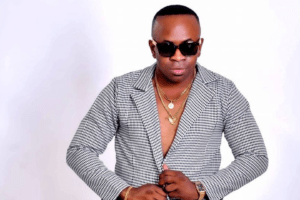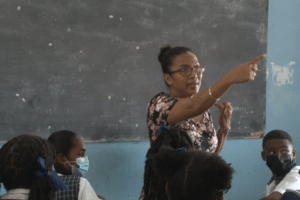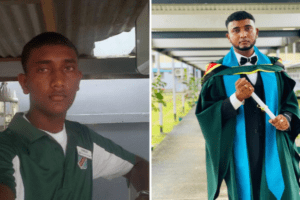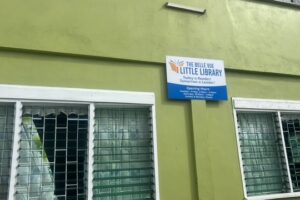It is generally believed that Guyana’s first inhabitants, the Amerindians, originally entered the territory of what is now known as Guyana about 11,000 years ago. Initially they lived on the low, swampy coastland region.
Origin Of The Amerindians
The First Amerindian Natives are postulated to have come from Asia through the Bering land bridge between 30,000–12,000 years before the present (BP). These conclusions have been based on cultural, morphological and genetic similarities between American and Asian populations.
Nine Tribes Of The Amerindians

Amerindian boy in Bamboo Village, North Pakaraimas
Today in Guyana there are, correctly speaking, four main tribes, namely the Warraus, Arawaks, Wapisianas and the Caribs, which include several sub tribes, Arrecunas, Akawaios, Patamonas, and the Macusis. The Wai-wais are also included in the Carib-speaking group.
- WAI-WAIS: These skilled architects of indigenous dwelling were fittingly tasked with the construction of the landmark Umana Yana. Expert weavers and bead designers, the members of this tribe love to dress up with cotton clothing and beaded ornaments. Their hairstyles are also works of art and they are very sociable people. The Wai Wais occupy the extreme south of the Rupununi Savannah.
- MACUSHIS: Richard Schomburg described this tribe as one of the most beautiful tribes of Guyana. The curare poison, which they blew, is used on the lips of their arrow and bow. This orderly tribe can be found in the Northern Rupununi Savannah.
- PATOMONAS: This tribe can be found mainly in the Northern Pakaraima Mountains, as well as in the South Pakaramais and the Essequibo region. Kaieteur Falls was named after Old Kaie, who was a member of the Patamona tribe.
- ARAWAKS: These coastal dwellers are skilled in fishing. They also plant cassava in abundance. This is their staple food, which is used to prepare many dishes and alcoholic drink called piwari.
- CARIBS: The Caribbean was named in honour. This is a warlike tribe who called themselves “Karina” and were feared and respected by more peaceful communities. Caribs have settled in the Barama and Pomeroon rivers, and on the coast of the North West district.The tribe cultivated cotton, which they spun into cloth with spindles and coloured with dyes from the barks and leaves of trees.
- WAPISHANA: Described as the most adaptable travellers, this tribe is famous for its industry and trading skills. They are also expert trackers, as well as weavers of hammocks, canoe makers, hunters and farmers.
- ARECUNAS: Originating from the Caron, a large tributary of the Orinoco, this tribe is located on the banks of the Kamarang river. In the olden days they grew cotton in commercial quantities, which they traded to the other tribes. Their weapon of choice was the blow-gun and they were experts in its manufacture.
- AKAWAIOS: This warlike tribe travelled from village to village, carrying the news and trading other tribes. They also, love to use the blowpipe. Members of the tribe are located in the Upper Mazaruni area, on the Barama, Upper Pomeroon, Demerara Wenamu, and the Upper Cuyuni rivers.
- WARRAUS: This tribe lives in the swamps and marshes of the North West District, in the low-lying areas of the Barima and Pomeroon rivers and their tributaries.
Known Facts About The Amerindians
A talented people, Amerindians are known even today for their craftsmanship. They can make canoes, baskets, pottery, hammocks, weapons, jewellery, utensils, clothing and buildings out of the materials that are around them. Materials include beads, stones, shells, wood, bamboo, calabash, leaves and tibisiri straw. Some of the best souvenirs to take home from Guyana are the crafts that are made by Guyana’s indigenous population. Many Amerindian communities in Guyana are involved in producing traditional and non-traditional handicrafts for sale; by supporting these projects, visitors help provide a much-needed source of income that is a viable alternative to some of the less sustainable options, including mining, logging, wildlife trade and over-hunting and fishing.
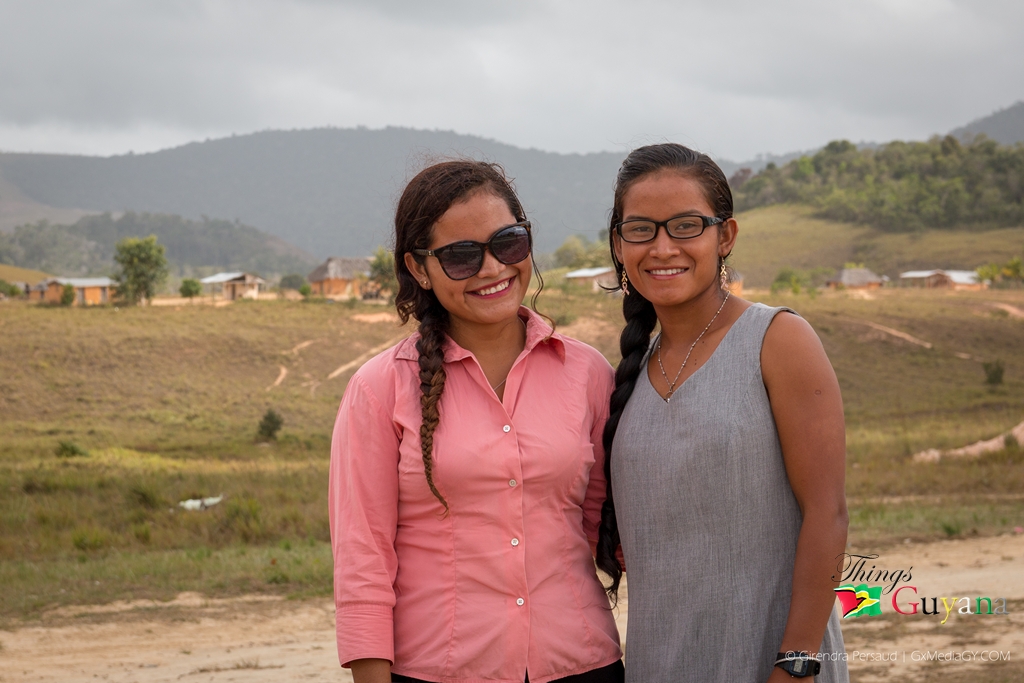
Amerindian Teachers (Also sisters), Kato Village, North Pakaraimas
One of the best places to shop for a range of Amerindian crafts from throughout Guyana is at the Ministry of Amerindian Affairs gift shop in Georgetown. The co-op of crafters and related gift shop at Santa Mission is also an excellent place to purchase gifts and souvenirs. There are a handful of craft projects in Guyana that are working hard to promote the importance of crafts for local families. Some items to look out for while at lodges in the Rupununi, include: salad servers, bowls, cutlery, jewellery boxes and animal figurines carved out of leopard wood by the Parashara Carving Group. Surama Village also sells bows and arrows made from the same beautiful wood.

Typical Amerindian Home: Tuseneng Village, North Pakaraimas
It is during the month of September, that Amerindian Heritage Month is observed and Amerindian culture is brought to the forefront and given significant recognition. September is used merely to highlight some of these developments and to allow Amerindians to showcase their involvement in the development process to the rest of the Guyanese society a little more than usual. Most of these activities are culturally based. They showcase, among other things, Amerindian dishes, dress, dances and art and craft. Amerindian Heritage Month has now become part of the national calendar of cultural events and so Guyanese look forward, especially to this month, to acquiring their treasured pieces of art and craft.While Amerindians may not have contributed to economic development as much as other sections of the Guyanese society, their contributions are unique, invaluable and irreplaceable as the development of a nation’s culture is as equally important as material development.

Amerindian Home, Kamana Village, North Pakaraimas
Beliefs Of The Amerindians
The basic Amerindian spiritual belief was animistic, which means that all objects and even the universe itself possessed personalities, souls or spirits. Some objects harboured GOOD spirits, while others possessed EVIL spirits. Spiritual Roots. Prior to European contact at the end of the 15th century, many now-extinct tribes existed with the remaining nine to form a conglomeration of independent, often conflicting tribes that had different customs, beliefs and languages. * Water * shamans * obeah.
Amerindian Foods
Amerindian cuisine is enjoyed by many which includes the perennial Pepperpot (Guyana’s national dish and a Christmas Day staple), but with more indigenous and exotic choices of meat, such as deer, bush cow (tapir) and labba (a step away from beef and pork) served with cassava bread, farine, and tea or wine.
The Tuma Sálâ is Guyana’s first restaurant offering Amerindian cuisine located at 37 Middleton Street, Campbellville, Georgetown.
Amerindians In Guyana
Amerindians are experts at using the resources from the rainforest. Many Amerindians still rely on traditional means of transport, that is canoe or foot. Other means include bicycles and motorcycles to a lesser degree. Amerindians are known to be great travellers travelling by foot or canoe up to weeks at a time. Amerindian cuisine is enjoyed by many. The perennial pepper pot is Guyana national dish and a Christmas Day staple. The Amerindians believes that the universe possessed personalities, souls or spirits. September is used merely to allow Amerindians to showcase their involvement in the development process to the rest of the Guyanese society. They are known for they unique craftsmanship such as canoes, hammocks, baskets just to name a few.
ARTICLE REFERENCES:
- http://guyanachronicle.com/2010/09/17/the-origins-of-guyanas-amerindians.
- http://guyanachronicle.com/2014/02/22/tuma-sala-guyanas-first-restaurant-offering-amerindian-cuisine.
- https://www.bradtguides.com/articles/amerindian-craft/?destination=50.
- https://www.kaieteurnewsonline.com/2012/09/04/treasured-craft-tuma-pot-wild-meat-offered-at-amerindian-exhibition/
- http://countrystudies.us/guyana/41.htm.
- https://www.stabroeknews.com/2014/sunday/arts-on-sunday/09/28/powerful-amerindian-presence-guyanese-culture/
- http://www.junglexplorer.net/peuples2_gb.htm


